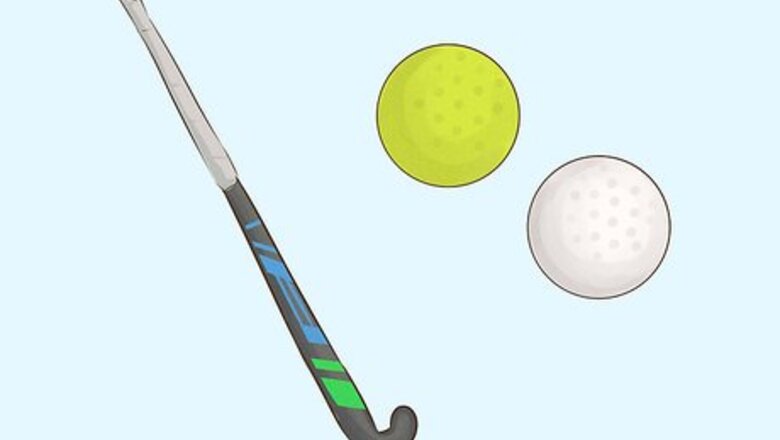
views
Gearing up to Play
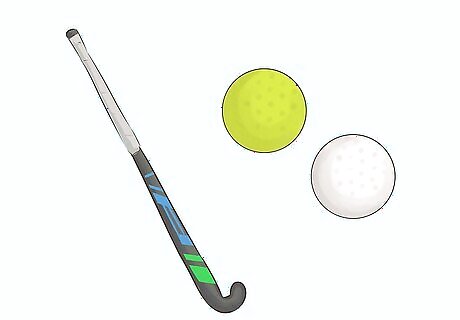
Get a field hockey stick and ball. There are plenty of brands, so shop around and find a stick that feels comfortable in your hands. A good stick will come up to about your hip when you hold its blade flat against the ground. Play around with the stick, taking some time to push around the small, hard ball used in field hockey games. The average weight of a field hockey stick is about 21 oz (600 g). Many forwards choose lighter sticks that are easier to maneuver. Many players also carry at least 2 sticks in case they play different positions. Every stick has a flat side and a rounded side. The flat side is the part you use to strike the ball. The ball is plastic and about the size of a golf ball. Advanced hockey sticks have a higher percentage of carbon fiber within them, which makes them more expensive. This also gives them more power, but less control. Less carbon fiber is usually better for beginner players.
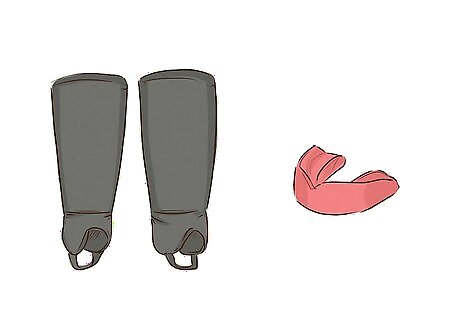
Purchase shin guards and a mouth guard, and goggles. These are the basic protective tools every field hockey player needs. The shin guards are similar to soccer shin guards but offer a little more ankle protection. You can wear socks underneath them to make them more comfortable. Mouthguards always tend to feel uncomfortable, but they are the most important protective gear available. Goggles help protect you from flying balls and high sticks. They protect the sides and front of your face. You can get gear online or at most sporting goods stores. If you have soccer shin guards, they can be a good starting point as you learn the game. Goalies also need a lightweight arm and leg padding as well as a caged helmet. Most players don't start off in goal, so consider learning the game as an outfield player before you decide on becoming a goalie. Gloves are optional pieces of equipment. Many players like wearing them for additional protection.
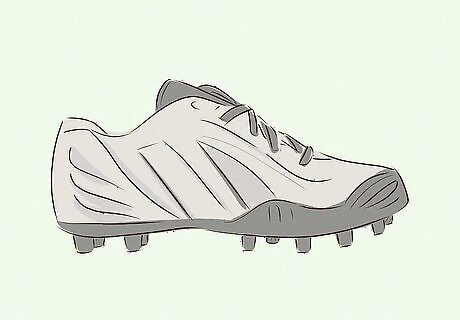
Wear field hockey cleats while playing. Field hockey matches are played on grass or turf like football, soccer, and other outdoor sports. Field hockey shoes have small, rubber cleats on the bottom that keep you from slipping while you run. Choose a pair of shoes that fit you but don't feel restrictive. If you have soccer cleats, start with those. The cleat studs are longer but still provide plenty of traction on the field. When you get more involved with field hockey, you can then choose specialty field hockey cleats.
Practicing the Basic Stance
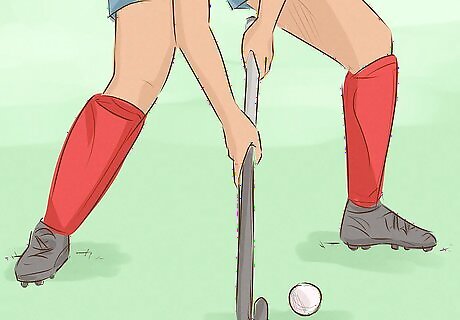
Hold the field hockey stick with your right hand at the bottom of the grip. Turn the stick so that the flat end faces away from you. Place your left hand over the top end of the stick, pointing your thumb down towards the curled end at the bottom. Position your right hand around the bottom of the grip, which is the black or white rubber or leather material ending about halfway down the stick. This basic grip is great for dribbling and controlling the ball. Roughly align your thumb with the curl at the end of the stick. Wrap your fingers around the grip, but be prepared to move them on occasion as you play. There is no such thing as a “lefty” stick. You can switch your hand positioning, but most left-handed players hold their sticks the same way as right-handed players.
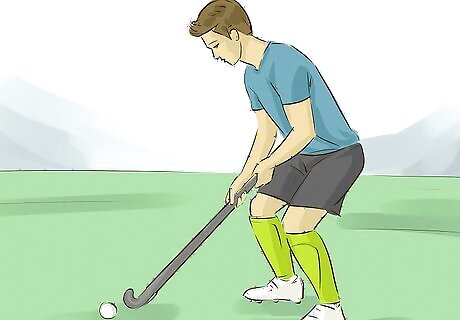
Crouch down with your knees bent and your back straight. Crouching is the normal position you hold while playing field hockey. Bend your body at the waist, pushing your stick out in front of you. Keep the curled end of the stick firmly on the ground with the flat end facing outwards. Make sure you keep your chest up so you are able to see the field ahead of you. Avoid leaning forward. Bend at the waist and keep your knees bent a little so you don't injure your back. You keep this crouched position most of the time on the field. The only time you stand up straight is if you're sprinting after a ball or standing in place.
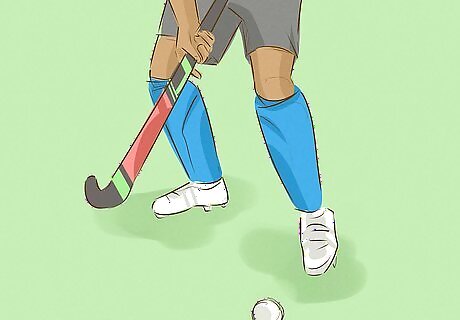
Stand with your left foot forward, pointing towards the ball. Aim for the ball, aligning your left foot with it. Place your right foot behind you for support. Keep the ball about a stick's length away from your body. Try to keep the ball in the same position relative to your body at all times. Avoid letting the ball get too close or too far from your body, or else it will be hard to control. If it gets away from you, move towards it instead of bending your back.
Mastering Playing Techniques
Press your stick against the ground to trap a moving ball. While facing the ball, lower your stick to the ground. Rest the stick's rounded edge on the ground and use it to stop the ball. You may need to step backwards a little to slow the ball before stopping it. Lean the stick forward to bring the ball to a stop. If you don't lean the stick forward slightly, the ball may roll over it and get past you. Trapping the ball allows you to control it so your passes and shots are more accurate. Be gentle when receiving the ball. Pretend it's an egg. Instead of breaking if you bump it too hard, the ball will roll away and the other team will get it. When passing or shooting, you'll want to try to break the egg. To practice, have someone else pass the ball to you until you feel comfortable stopping it.
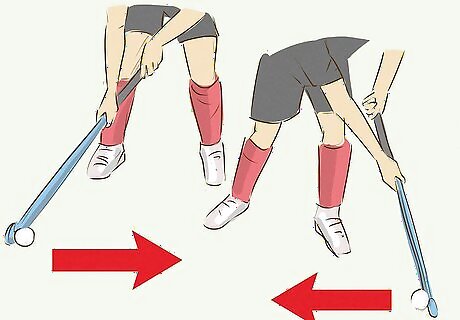
Perfect the Indian dribble or reverse stick to move the ball upfield. Position the ball in front of you and place your stick next to it. When the ball is on your left, flick the ball to your right. Then, twist the stick with your left hand until the flat side is to the right of the ball. Flick the ball back to your left and continue doing this for as long as you can. Dribbling this way is excellent for keeping the ball in your possession as you move. Remember to always tap the ball with the flat side of the stick. Even experienced players can have a hard time mastering this technique. Try dribbling in place first. Once you have mastered that, walk up the field while dribbling.
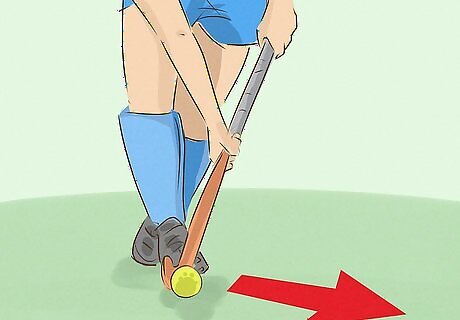
Step towards the ball as you hit it to perform a sweep pass. Face the ball and position it slightly ahead of you. Bring the head of your stick down towards the ball. As you make contact with the ball, bring your weight down on your front foot. Your front foot is the one closest to the spot where you want the ball to go. A sweep pass or push is a basic pass that provides plenty of control and accuracy when you need to get the ball to a teammate. Keep 1 foot close to the ball and 1 foot behind you. When you move to hit the ball, bring your back foot forward to generate power. A sweeping pass is similar to how you would hit a ball in mini-golf. Follow through with your swing, but don't try to slap the ball. Remember that you are pushing the ball towards the target. A variation is to dig your stick underneath the ball, then lift it up and push it towards your target.

Squat to perform a hook pass for balls further away from you. Place your stick parallel to the ground, similar to what you do when stopping a ball. Wrap the hooked part of your stick around the ball. Transfer your weight from your back foot to your front foot as you swing the stick forward in a single, smooth motion. Use your legs to maintain your balance and generate force. Avoid leaning forward more than you need to to reach the ball. The hook pass allows you to get to balls out of your reach. It probably won't feel as accurate as sweep passes at first, so keep practicing!
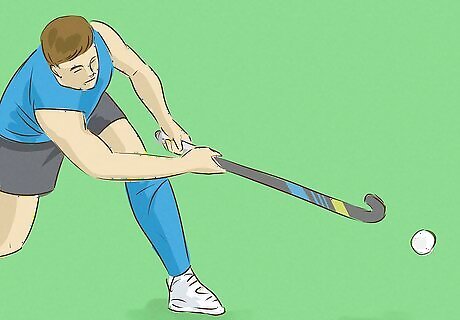
Bring your hands together to perform a slap shot. Stand with the ball ahead of you and keep your left hand around the top of the stick. Slide your right hand up, maintaining a strong grip on your stick. Bring your stick back behind you to start your swing. As you bring your stick forward, shift your weight onto your front foot. Swinging your club this way is similar to driving a ball far in golf or cricket. For more accuracy, push the ball on the ground instead of trying to hit it with power. Remember that you can only shoot the ball by hitting it with the flat part of your stick while inside the scoring circle.
Training for a Match
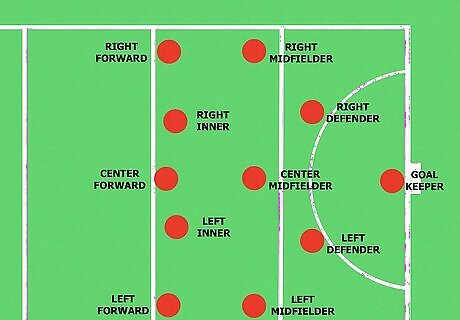
Choose a position to play on the field. A field hockey team consists of 11 players. The number of forwards, midfielders, and defenders on the field depends on the formation the coach chooses. The final player on the field is the goalie, who stays near the goal to block shots. Forwards score goals, defenders block goals, and midfielders do a little of both. Try to pick a position that fits you best. You may even get to play multiple positions sometimes.
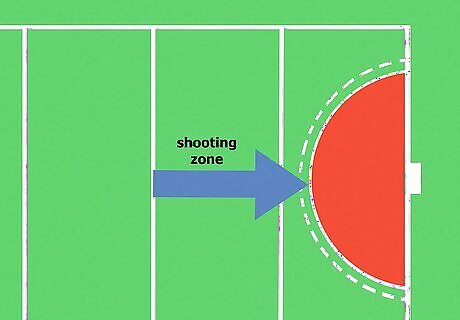
Shoot the ball only when you're standing in the shooting zone. When you look at a field hockey field, you will see a semi-circle around the goals. These are the shooting zones, and you have to be standing in them in order to score. If you shoot the ball while standing outside of the zone, the goal doesn't count and the other team gets the ball. Make sure you only shoot with the flat side of the stick as well. The rounded side cannot be used at all.
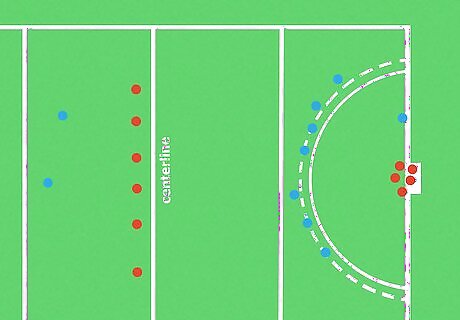
Take a short corner when a foul is committed inside the shooting zone. The short corner is perhaps the hardest part of the game to understand. When it happens, 5 defenders stand in front of the shooting zone. The rest of the defending team has to wait behind the centerline of the field until the team on offense touches the ball. A short corner is basically a power play in sports like hockey, indoor soccer, or lacrosse. For very bad fouls, such as trying to harm another player, the referee may award a penalty stroke. A player for the offense takes a 1-on-1 shot against the goalie.
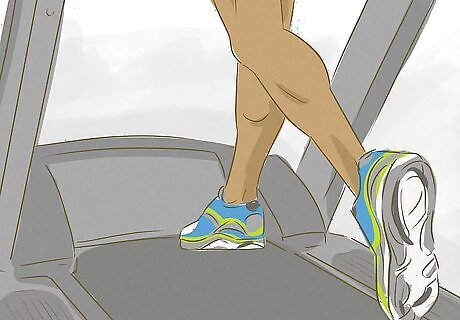
Spend a lot of time running during practice. Keep in shape, especially if you are a midfielder. All players need to be able to run without tiring. A regular field hockey game consists of 2 35-minute halves, so it involves a lot of endurance. Build your stamina as much as you can. Remember that, during a game, you run while holding and using your stick. Run with it in practice so you can get used to carrying it in a match.
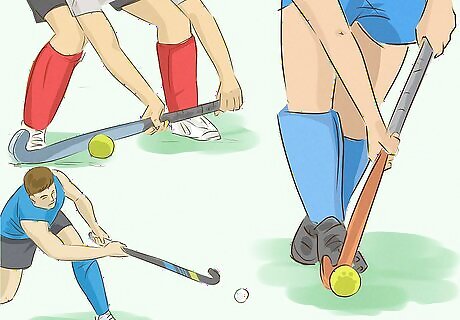
Practice wearing and using your gear. Bounce the ball along the flat length of your stick. Dribble it wherever you go. Work on turning with the ball, pulling it towards you, and passing it to a teammate. Every action helps you become a better field hockey player. Make sure you get comfortable wearing shinguards, a mouth guard, and gloves, if you use them. Try asking a coach for help or sign up with a recreational team. Many colleges also have field hockey programs. Remember that even the best players start somewhere. Practice often, but have fun playing.
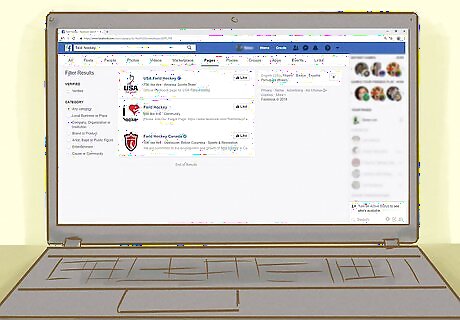
Speak to a player or coach to join a field hockey team. The best way to get more information about teams is to find out where they play. Many communities have recreational leagues for all ages. Universities also tend to field teams. Search online for clubs in your area and ask players and coaches how they got started with the sport. If you can't find a team, you can always try organizing your own in your community.




















Comments
0 comment